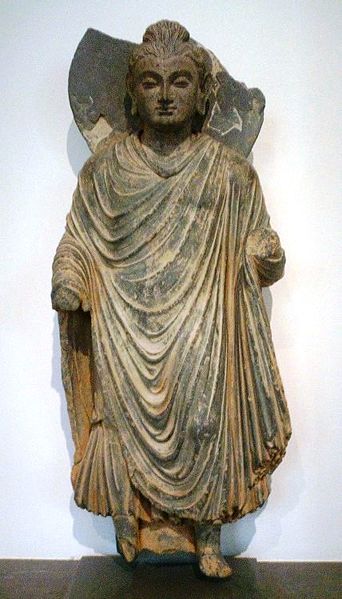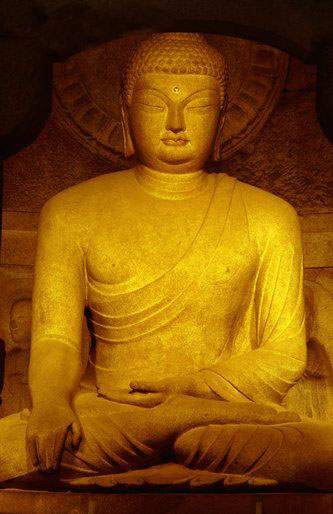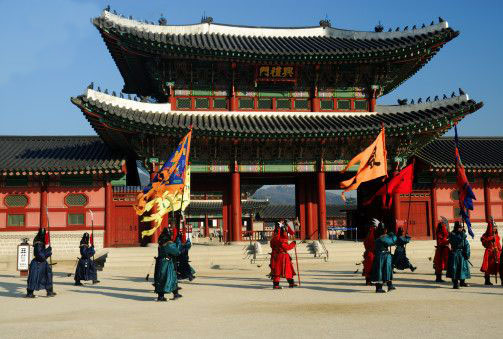
My religion is Buddhism. It started from my ancestor.
Buddhism is one of the main stream of religions in Korea.

Buddhism in Asia
There are two major divisions of Buddhism. The Hinayana, or Modest Vehicle, emphasizes personal liberation, while the Mahayana, or Vast Vehicle, stresses working to become a fully enlightened Buddha in order to be best able to help others. Each has many sub-divisions. At present, however, three major forms survive: one Hinayana, known as Theravada, in South East Asia, and two Mahayana, namely the Chinese and Tibetan traditions.The Theravada tradition spread from India to Sri Lanka and Burma in the third century B.C.E., and from there to Yunnan in southwest China, Thailand, Laos, Cambodia, South Vietnam and Indonesia. Pockets of Indian merchants practicing Buddhism were soon found on the coast of the Arabian Peninsula and even as far as Alexandria, Egypt. Other forms of Hinayana spread from that time to modern-day Pakistan, Kashmir, Afghanistan, eastern and coastal Iran, Uzbekistan, Turkmenistan and Tajikistan. These were the ancient states of Gandhara, Bactria, Parthia and Sogdia. From this base in Central Asia, they spread further in the second century C.E. to East Turkistan (Xinjiang) and further into China, and in the late seventh century to Kyrgyzstan and Kazakhstan. These forms of Hinayana were later combined with Mahayana aspects that also came from India so that Mahayana eventually became the dominant form of Buddhism in most of Central Asia.The Chinese form of Mahayana later spread to Korea, Japan and Vietnam. Another early wave of Mahayana, mixed with Shaivite forms of Hinduism, spread from India to Nepal, Indonesia, Malaysia and parts of South East Asia starting in about the fifth century. The Tibetan Mahayana tradition, which, starting in the seventh century, inherited the full historical development of Indian Buddhism, spread throughout the Himalayan regions and to Mongolia, East Turkistan, Kyrgyzstan, Kazakhstan, northern Inner China, Manchuria, Siberia and the Kalmyk Mongol region near the Caspian Sea in European Russia.

Buddhism in Korea
Korean Buddhism is distinguished from other forms of Buddhism by its attempt to resolve what it sees as inconsistencies in Mahayana Buddhism. Early Korean monks believed that the traditions they received from China were internally inconsistent. To address this, they developed a new holistic approach to Buddhism. This approach is characteristic of virtually all major Korean thinkers, and has resulted in a distinct variation of Buddhism, which Wonhyo (617–686) called the Tongbulgyo ("interpenetrated Buddhism"). Korean Buddhist thinkers refined their predecessors' ideas into a distinct form.As it now stands, Korean Buddhism consists mostly of the Seon lineage. Seon has a strong relationship with other Mahayana traditions that bear the imprint of Chinese Ch'an teachings, as well as the closely related Japanese Zen. Other sects, such as the Taego, the modern revival of the Cheontae lineage, the "Jingak" order (a modern esoteric sect), and the newly formed Won, have also attracted sizable followings numbering from 800,000 up to 5,000,000 adherents.
 Buddhist Temple in Korea
Buddhist Temple in Korea
In Korea, each temple has its individual layout but in general, there are gates (three in number), a Main Buddha Hall, monks quarters, guests rooms, kitchens, meditation and study halls. Apart from this, a temple might also include any number of lesser halls, pavilions and shrines. The Main Buddha Hall is the most important building and lies in the direct line of the gates. Important shrines found in the temple include Hall of Avalokitesvara (Bodhisattva of Compassion) and the Judgment Hall (for funerals and memorial services). Quiet often shrines to the Big Dipper and the local Mountain God that reflect Buddhism's amalgamation with folk religions are also found in the temple. Pagodas, stone lanterns, stupas, memorial steles and other artifacts are other attractions that you can see in the temple compound during your visit.While paying a visit, you will realise that a whole lot of these temples have names that end with sa. The reason for this is that in Korean language, sa translates into temple. Some of the most important temples that you must pay a visit to during your trip include Beomeosa, Beopjusa, Haeinsa, Tongdosa and Donghaksa.Tongdosa, Haeinsa and Songgwangsa are the Three Jewel Temples of Korea that each stand for a jewel of Buddhism - Buddha, Dharma and Sangha. The Three Jewel temples are a bit different other Buddhist temples of Korea because unlike latter, the former do not have daeungieon or the Central Hall as the most important building. Rather, in the Three Jewel temple, the most important building is the one that highlights the individual jewel of the temple.
Hīnayāna is a Sanskrit and Pali term literally meaning:, "the low vehicle", "the inferior vehicle", or "the deficient vehicle", where "vehicle" (yāna) means "a way of going to enlightenment".According to the MacMillan Library Reference Encyclopedia of Buddhism, it is a polemical term coined by Mahāyāna Buddhists to denigrate their opponents. The term appeared around the 1st or 2nd century CE. Its use in scholarly publications is controversial. There are differing views on the use and meaning of the term, both among scholars and within Buddhism.The legitimacy of using the term Hinayana to refer to the early Buddhist schools, including the contemporary Theravada, is disputed. In the Chinese, Korean, Vietnamese and Japanese languages, the term is not pejorative (小 meaning "small", 乘 meaning "vehicle"), and in the Tibetan language (theg chung) the word is only slightly pejorative (chung meaning "small" or "lesser"). By some it is used with respect proper to teachings coming direct from the Buddha.
Generally, scholars conclude that the Mahayana scriptures were composed from the first century CE onwards, five centuries after the historical Gautama Buddha, with some of them having their roots in other scriptures, composed in the first century BCE. The Mahayana sutras are thus not included in the more ancient Agamas, nor in the Sutta Pitaka of the Theravada, both of which represent an older stratum of Buddhist scriptures, of which some scholars claim that it can be historically linked to Gautama Buddha himself.Although all Mahayana sutras begin with the sentence "thus have I heard", mentioning the same locations as the Pali Canon, some scholars contend that the Mahayana sutras were mainly composed in the southof India, and that later the activity of writing additional scriptures was continued in the east and north of India.
Theravada literally, "the Teaching of the Elders", or "the Ancient Teaching") is the oldest surviving Buddhist school. It is relatively conservative, and generally closest to early Buddhism, and for many centuries has been the predominant religion of Sri Lanka (about 70% of the population) and most of continental Southeast Asia (Cambodia, Laos, Burma, Thailand). It is also practised by minorities in parts of southwest China (by the Shan and Tai ethnic groups), Vietnam (by the Khmer Krom), Bangladesh (by the ethnic groups of Baruas, Chakma, and Magh), Malaysia, Philippines and Indonesia, whilst recently gaining popularity in Singapore and Australia. Today Theravada Buddhists number over 100million worldwide, and in recent decades Theravada has begun to take root in the West and in the Buddhist revival in India.
Haeinsa(an example of temple)
Located on Gaya Mountain in Hapcheon-gun region in South Gyeongsang Province, the Haeinsa Temple is one of the three Jewel Temple of South Korea that represent three jewels of Buddhism- Buddha, dharma and sangh. Haeinsa temple stands for dharma or Buddha's teachings. The name of the temple "Haein" is drawn from the expression Haeinsammae of Hwaeomgyeong (Buddhist scripture), which means truly enlightened world of Buddha and our naturally unpolluted mind.